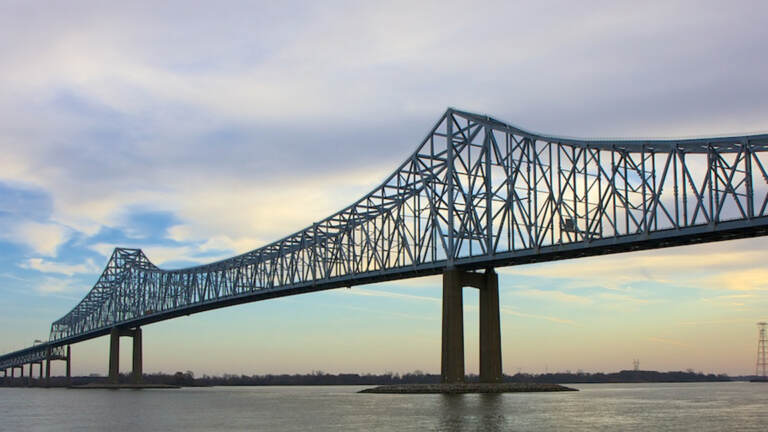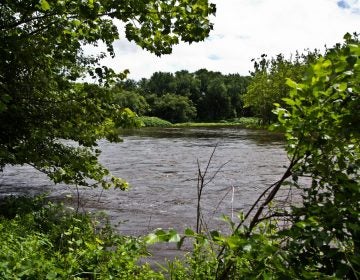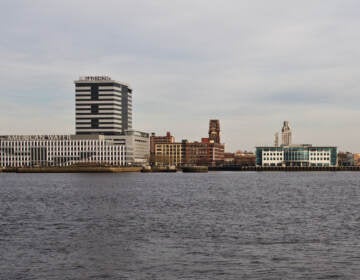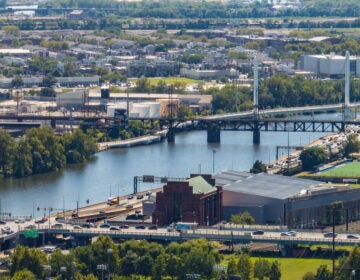Oxygen levels in Delaware River met standards, commission says
The environmentalists urged the DRBC to almost double its required oxygen standard so that resident and migratory fish would be better able to thrive in the river.

According to USGS data, in 2020 dissolved oxygen levels dropped to as low as 2.8 milligrams per liter in the Delaware River at the Commodore Barry Bridge, which links New Jersey with Chester, Pennsylvania. (Michael W. Murphy Flickr; CC BY-SA 2.0)
This story originally appeared on NJ Spotlight.
The Delaware River Basin Commission rejected a claim by environmental groups that oxygen levels at two sites in an urban section of the river fell below the regulator’s own standards at times during the last three summers.
The commission said that dissolved oxygen remained at or above the required 3.5 milligrams per liter at Chester, Pennsylvania and Penn’s Landing in Philadelphia throughout the summers of 2019, 2020 and 2021, when measured as 24-hour averages, not as snapshots taken by water monitors operated by the U.S. Geological Survey.
The environmentalists, led by Delaware Riverkeeper Network, wrote to the commission on Sept. 9, urging it to almost double its required oxygen standard to 6.3 mg/L so that resident and migratory fish would be better able to thrive in the river. They said the USGS data showed that the tidal section of the river is sometimes not compliant with the commission’s requirements on oxygen content, and that endangers the survival of fish, especially the critically endangered Atlantic sturgeon.
But the commission said environmentalists were wrong to base their claims on water samples taken at specific moments.
“The attainment of water quality standards is not measured by instantaneous records such as the two you reference in your letter,” the DRBC’s executive director, Steve Tambini, replied on Oct. 4. “At both Chester, PA and Philadelphia, PA, the dissolved oxygen water quality criteria were met throughout the summers of 2019, 2020 and 2021.”
Snapshot versus average
The riverkeeper network rejected the commission’s argument that oxygen should be measured as a 24-hour average rather than a snapshot. It cited a report to the commission by fisheries biologists in 1979, which said 24-hour averages were not an appropriate gauge of oxygen levels.
“From a fisheries management viewpoint, events occurring in time periods much less than 24 hours can be detrimental to fish survival,” that report said.
Erik Silldorff, restoration director for Delaware Riverkeeper, said the 24-hour average is not the right way to think about saving fish. “DRBC says, ‘Hey, we’re doing fine, we’re meeting the 3.5 mg/L standard.’ That’s embarrassing that they would even say that,” Silldorff said.
In the commission’s response letter, Tambini said scientists are working on a study that will determine how to build on what he called “extraordinary” water-quality improvements in the river during the last 50 years. And he rejected claims by environmental activists that the commission is dragging its feet on the study.
“We are proceeding on our established course as quickly as possible and practicable consistent with sound scientific practices and available resources,” he said.
The study began in 2017 and was extended because of delays caused by the COVID-19 pandemic. It is now scheduled to end in September 2022.
When study is complete, the commission’s executive director will propose a new rule to establish designated uses and set a water-quality standard to support those uses in Zones 3 and 4 and the upper portion of Zone 5 of the river — a stretch that includes Camden, and goes from the Tacony section in northeastern Philadelphia to Wilmington, Delaware.
Environmental groups say oxygen levels could be boosted if wastewater plants were required to install a technology called nitrification, which reduces the ability for nitrogen discharges to deplete oxygen in the river. Unless that process is used, the river’s widely heralded cleanup since the mid-20th century will remain unfinished, they say.
The commission regulates water flows for the four basin states — New Jersey, New York, Pennsylvania and Delaware — plus the federal government.
WHYY is your source for fact-based, in-depth journalism and information. As a nonprofit organization, we rely on financial support from readers like you. Please give today.





